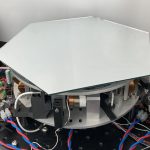
AdLaS – Adaptive mounting system with powerless gravity compensation for mirror segments in large telescopes
Project Focus
- Active suppression of floor vibrations by acceleration feedback control
- Zero-power gravity compensation at an arbitrary operating point using electropermanent magnets
- Position control for six degrees of freedom
Description
Vibration isolation is indispensable in many high-precision applications, both in industry and research. Prominent examples are wafer scanners, atomic force microscopes and large-scale reflecting telescopes. The stringent requirements cannot be met by purely passive systems and require active control strategies. Motivated by the high relevance, a suspension system for heavy loads with a levitating platform, active vibration suppression and integrated gravity compensation was designed, implemented and evaluated in this project.
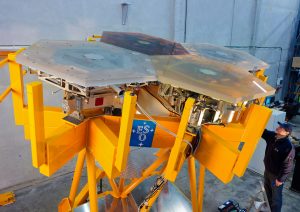
Four segments of the primary mirror of the Extremely Large Telescope (ELT) (Source).
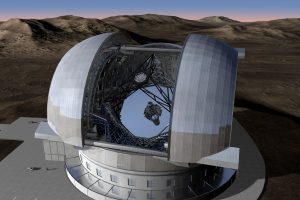
3D model of the Extremely Large Telescope (ELT). The primary mirror has a diameter of 39.3 m and consists of 906 segments (Source).
The levitating platform has six degrees of freedom (DoF), which are actuated by Lorentz actuators due to their linearity and quasi-zero stiffness. In order to avoid heat dissipation, which may have a negative effect on sensitive equipment, zero-power gravity compensation is integrated. This is achieved by using electropermanent magnets (EPM) which, compared to other approaches, enable the adaption to a variable payload mass while keeping the operating point of the platform constant.
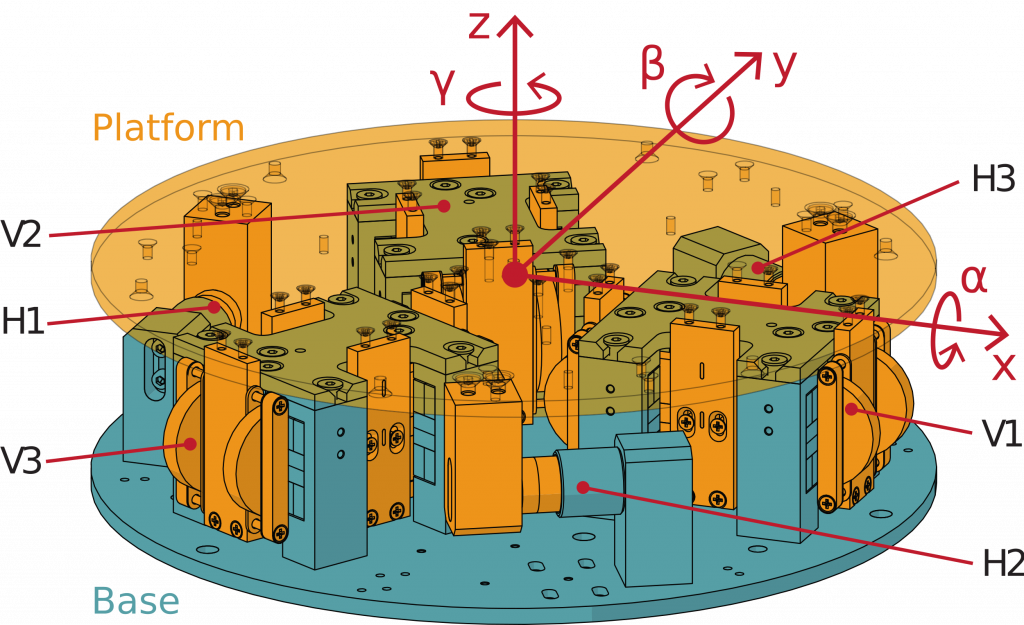
3D rendering of the vibration isolation system, showing the base (blue) and the levitating platform (orange). The Lorentz actuators with integrated EPMs V1, V2 and V3 are responsible for the out-of-plane DoFs z, α, β, and the voice coils H1, H2 and H3 for the in-plane DoFs x, y, γ.
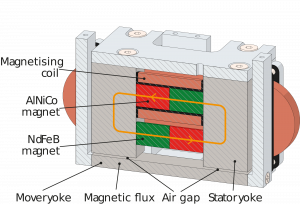
If the EPM is deactivated, the magnetic flux closes within the stator and the mover yoke is not attracted.
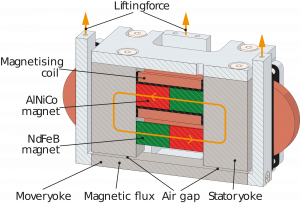
If the EPM is activated, the magnetic flux closes through the mover yoke which is attracted.
Particular attention has to be paid to the control design due to the conflicting goals of position control and vibration suppression. For the positioning of the platform, decentralised control is used with a suitable decoupling of the six DoFs. The displacement is measured with six eddy current sensors. Moreover, the platform is equipped with an accelerometer, which is used to apply acceleration feedback. This increases the effective mass and reduces the transmission of floor vibrations. To achieve a lower position control bandwidth, which reduces the transmission of low-frequency disturbances, the negative stiffness of the EPMs is compensated by a positive virtual stiffness.
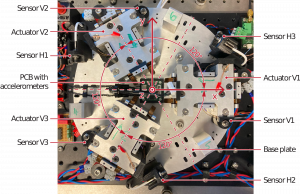
The six actuators and eddy-current sensors are arranged on a circle with an offset of 120°. In the centre of the base and the platform acceleration sensors are mounted.
The decentralised position control achieves a bandwidth of 60 Hz in the out-of-plane DoFs and 20 Hz in the in-plane DoFs with a resolution of less than 100 nm. For vibration isolation, the crossover frequency of the position control in the vertical direction is reduced to 6 Hz, resulting in an attenuation of floor vibrations with -40 dB/decade starting at around 8 Hz. With the additional acceleration feedback, the transmissibility was further reduced by almost 10 dB. The evaluation of the gravity compensation showed that it can support a total load of 6.34 kg while reducing the power consumption by 99 %.
Video Prototype of the vibration isolation system with a mounted mirror segment.
Applications
- Mounting of mirror segments in large reflecting telescopes
- Vibration isolation for sensitive measuring equipment (e.g. atomic force microscope)
Videos and Publications
Funding
Austria Wirtschaftsservice (AWS) prototype funding (project name: AdLaS – Adaptive mounting system with powerless gravity compensation for mirror segments in large telescopes, project number: P2389218)
Contact
Associate Prof. Dipl.-Ing. Dr.techn. Ernst CsencsicsUniv.-Prof. Dipl.-Ing. Dr.sc.techn. Georg Schitter
Project Staff
Univ.Ass. Dipl.-Ing. BSc Benjamin FriedlDipl.-Ing. BSc. Alexander Pechhacker